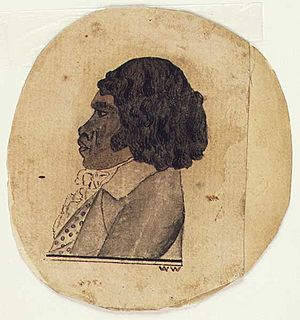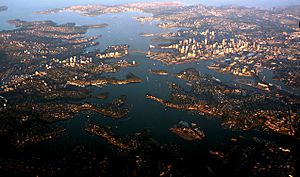Wangal facts for kids
The Wangal people (also known as Wanegal or Won-gal) are a group of Aboriginal people. They are part of the larger Dharug nation. For thousands of years, the Wangal people have been the traditional owners and caretakers of the land and waters in what is now the Inner West of Sydney, New South Wales. This area includes places like Strathfield, Burwood, Canada Bay, and parts of Parramatta.
Contents
A Long History in Sydney
Scientists have found signs that people lived along the Parramatta River as far back as 20,000 years ago. It's possible they were there even earlier! People have lived in other parts of Australia for more than 60,000 years.
Sydney's Ancient Landscape
Imagine Sydney 20,000 years ago, during the last ice age. The coast was much further out, about 15 kilometers to the east. What we now call Sydney Harbour was actually freshwater creeks and rivers. The ancestors of the Wangal people lived in these coastal areas, which are now under the sea.
As the ice melted and sea levels rose, people living on the coast had to move further inland. By 1788, when the British arrived, the Wangal people were well-known for their fishing skills.
First Meetings with Europeans
The Wangal people were among the first Aboriginal groups to meet British settlers in 1788. The British governor, Arthur Phillip, wanted to build good relationships with the local people. He even became friends with Bennelong, an important Wangal leader.
However, the different ways of life between the groups led to problems. Both sides sometimes harmed or killed members of the other.
In April 1789, just over a year after the British settlement began, a terrible disease called smallpox spread. This disease had a devastating effect on the Aboriginal population.
Wangal Country
The Wangal people called their land Wann or Wanne. Governor Arthur Phillip wrote about this name in 1790. Their country stretched along the south side of Sydney Harbour. It went from Long Cove (now Iron Cove) all the way to Rose Hill, which the local people called Parramatta.
Today, most of Wangal country is in the "Inner West" of Sydney. This includes areas like Strathfield, Burwood, and Canada Bay. It also covers parts of the former Ashfield Council area. To the east, Wangal country meets the land of the Cadigal people. To the west, it reaches Homebush Bay and Sydney Olympic Park. Here, it meets the country of the Burramattagal people.
Language of the Wangal
The Wangal people speak a language that is part of the Dharug (also known as Dharuk) language group. The Dharug language has given us many words that we use in Australian English today. These include words like dingo, woomera (a spear-thrower), wallaby, wombat, and waratah.
The Wangal people and their neighbours, the Cadigal people, were greatly affected by the early British settlement. Many died from smallpox. Others were forced off their lands by the new settlers. Within about 20 years of 1788, it became very hard to find Wangal people living in their traditional ways.
Today, the Dharug language has been put back together. This was done using many notes made by the first British colonists. For over a hundred years, there was no one known to speak the language every day.
See also



